Papers by Giovani Da Costa Caetano

O objetivo neste trabalho foi descrever a curva de crescimento de codornas de corte por meio de ... more O objetivo neste trabalho foi descrever a curva de crescimento de codornas de corte por meio de modelos Splines, e comparar os resultados com o modelo nao linear de Gompertz. Para o desenvolvimento deste estudo foi utilizado um banco de dados de codornas de corte (Coturnix coturnix) do programa de Melhoramento de Aves da Universidade Federal de Vicosa, com 10 geracoes de dois grupos geneticos (UFV1 e UFV2), sendo 6.724 animais da UFV1 e 6.539 da UFV2. Os dados de pesos foram coletados semanalmente, do nascimento aos 42 dias, totalizando em sete medidas de peso corporal por animal. A analise dos dados foi feita no programa SAS® 9.4.e os criterios para a escolha do melhor modelo de ajuste foram: criterio de informacao de Akaike (AIC), criterio de informacao bayesiano de Schwarz (BIC), coeficiente de determinacao ajustado (R 2 aj), coeficiente de determinacao (R 2 ), porcentagem de convergencia (C%) e o quadrado medio do erro de predicao (MEP). O modelo que mais se ajustou aos dados...

Archivos de Zootecnia
A epigenética é definida como mudanças na expressão gênica que podem ser herdadas e que não alter... more A epigenética é definida como mudanças na expressão gênica que podem ser herdadas e que não alteram a sequência do DNA. Existem dois mecanismos epigenéticos principais, a metilação do DNA e a modificação de histonas. Também se destaca o imprinting genômico, o qual está relacionado com a regulação gênica quando apenas um alelo (herdado do pai ou da mãe) se expressa. A herança epigenética transgeracional consiste da herança de marcas epigenéticas através de células germinativas, que controla os padrões de expressão gênica e são passados de uma geração para a outra. Dentro do programa de melhoramento animal é importante avaliar a extensão com que a herança epigenética transgeracional também afeta a eficiência da seleção. Uma melhor compreensão dos mecanismos epigenéticos e seus efeitos transgeracionais no desempenho dos animais poderá permitir maiores ganhos sobre as características de importância econômica.
Arquivo Brasileiro de Medicina Veterinária e Zootecnia
Avaliação da imobilidade tônica em codornas de corte via análise de sobrevivência [Tonic immobili... more Avaliação da imobilidade tônica em codornas de corte via análise de sobrevivência [Tonic immobility evaluation in meat quail via survival analysis]

Archivos de Zootecnia
O melhoramento animal é uma ciência preditiva que tem na variabilidade genética do rebanho a sua ... more O melhoramento animal é uma ciência preditiva que tem na variabilidade genética do rebanho a sua base e na seleção uma importante ferramenta de ação, cuja eficiência é ponderada pela herdabilidade das características de importância econômica, que é um parâmetro específico de cada rebanho. Por ser bom indicador das consequências do manejo genético nos sistemas de produção, a herdabilidade recebeu atenção da pesquisa e contribuição da evolução de recursos computacionais e de métodos estatísticos para a estimação de seus componentes de variância, resultando em estimativas com maior precisão, inicialmente pelo método de mínimos quadrados, em seguida por máxima verossimilhança e estatísticas bayesianas. O rebanho Nelore do Brasil passou por essas etapas no seu processo de melhoramento genético, que tem sido norteado pela seleção em características de crescimento (pesos em idades padrão) como fenótipos de interesse econômico, que apresentam herdabilidade de moderada a alta magnitude. A he...
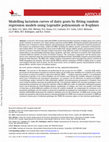
Canadian Journal of Animal Science
A total of 17 356 test-day milk yield (TDMY) records from 642 first lactations of Alpine goats we... more A total of 17 356 test-day milk yield (TDMY) records from 642 first lactations of Alpine goats were used to model variations in lactation curve using random regression models (RRM). Orthogonal Legendre polynomials and B-splines were evaluated to obtain adequate and parsimonious models for the estimation of genetic parameters. The analysis was performed using a single-trait RRM, including the additive genetic, permanent environmental, and residual effects. We estimated the mean trend of milk yield, and the additive genetic and permanent environmental covariance functions through random regression using different orders of orthogonal Legendre polynomial (three to six) and B-spline functions (linear, quadratic, and cubic, with three to six knots). This study further evaluated different number of classes of residual variances. The covariance components and the genetic parameters were estimated using the restricted maximum likelihood method. Heritability estimates presented similar trends for both functions. The RRM with a higher number of parameters better described the genetic variation of TDMY throughout the lactation. The most suitable RRM for genetic evaluation of TDMY of Alpine goats is a quadratic B-spline function with six knots, for the mean trend, curves of additive genetic and permanent environmental effects, and five classes of residual variance.

Livestock Science, 2017
Abstract We estimated genetic correlations between partial and total body weight gain (BWG) and i... more Abstract We estimated genetic correlations between partial and total body weight gain (BWG) and individual feed conversion (FC) aiming to identify possible partial traits as selection criteria in meat quail breeding programs. Data included 379 records from two different genetic lines (188 quails from UFV1 and 191 from UFV2). The following traits were evaluated: individual feed conversion from 21 to 28 (FC21–28) and from 28 to 35 days of age (FC28–35); body weight gain from 1 to 21 (BWG1–21), 21–28 (BWG21–28), 28–35 (BWG28–35) and from 1 to 35 (BWG1–35, full period) days of age. Genetic parameters (heritabilities and genetic correlations) were estimated through multi-trait models via Bayesian inference. For UFV1 line, genetic correlations estimates (with respective credible intervals) between BWG1–21 and BWG1–35, BWG21–28 and BWG1–35, BWG28–35 and BWG1–35, FC21–28 and FC28–35, FC21–28 and BWG1–35, and FC28–35 and BWG1–35 were 0.62 0.15–0.90), 0.81 0.60–0.94), 0.69 0.35–0.88), 0.06 (−050 to 0.60), −0.87 (−0.97 to −0.63) and −0.51 (−0.84 to −0.01), respectively; and for UFV2 line, these estimates were 0.33 (−0.05 to 0.63), 0.79 0.59–0.92), 0.88 0.73–0.96), 0.35 (−0.30 to 0.78), −0.56 (−0.85 to −0.09) and −0.76 (−0.93 to −0.41), respectively. Additionally, for the UFV1 line heritability estimates for BWG21–28 and FC21–28 were 0.69 0.40–0.86) and 0.55 0.31–0.74), respectively; while for UFV2 line the heritabilities for BWG28–35 and FC28–35 were 0.68 0.47–0.83) and 0.37 0.17–0.63). Based on these results, we recommend as target traits BWG21–28 and FC21–28 for UFV1 line; and BWG28–35 for UFV2 line. Selecting for these indicated traits, we expect to reduce breeding program costs related mainly to feeding of non-selected animals and labor with phenotyping.
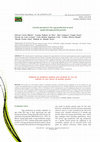
Ciência Rural, 2017
ABSTRACT: We estimated genetic and phenotypic parameters for egg production in meat-type quails a... more ABSTRACT: We estimated genetic and phenotypic parameters for egg production in meat-type quails aiming to propose an optimal age for selection through partial record egg production. Data of 3,503 female quails from two strains (namely, UFV1, with 1,811 and UFV2 with 1,692 females) were used. Egg production was assessed by the number of eggs recorded after 42 days of age and each partial period consisted on 35 days of egg production forward. Covariance components were estimated by using single and bivariate animal model, comprising each partial period of egg production and full egg production period (one year of egg laying). Regarding strain UFV1, heritability estimates ranges from 0.03 to 0.16, and for strain UFV2 0.20 to 0.25. The highest genetic correlation with full egg production was with second period (0.64) for strain UFV1 and with third period (0.47) for UFV2. Therefore, animal selection based on egg production until 112 days for the strain UFV1 and 147 days for the strain UF...

Arquivo Brasileiro de Medicina Veterinária e Zootecnia, 2016
O presente trabalho teve por objetivo avaliar a conversão alimentar (CA) por meio da inferência b... more O presente trabalho teve por objetivo avaliar a conversão alimentar (CA) por meio da inferência bayesiana considerando-se análises bivariadas. Foram utilizadas diferentes espécies animais de experimentos conduzidos na Universidade Federal de Viçosa, no estado de Minas Gerais, Brasil. O modelo proposto mostrou ser apropriado, uma vez que possibilitou a detecção de diferenças significativas entre níveis de fatores não detectados por procedimentos frequentistas em ANOVA tradicional, principalmente em pequenas amostras. No experimento com codornas, evidenciou-se que aves cujos níveis de proteína bruta eram de 23% e 29%, respectivamente, para machos e fêmeas, apresentaram uma melhor CA, de 2,83±0,03 e 2,66±0,03, respectivamente. No experimento com frangos, no grupo sem o aditivo antibiótico, a inclusão de 0,02% de extrato de ésteres naturais foi o que promoveu a melhor CA (1,72±0,01), e, de modo geral, o uso de antibiótico e a ausência de ésteres naturais promoveram CA de 1,63±0,02. Em c...

Revista Brasileira de …, 2012
The objective of this study was to obtain estimates of genetic and phenotypic parameters for egg ... more The objective of this study was to obtain estimates of genetic and phenotypic parameters for egg mass of meat quails and also to propose an optimal age for selection of birds through the egg mass. The data used in this study came from 3,503 female meat quails (UFV1: 1.811 quails; UFV2: 1.692 quails) of the Poultry Breeding Program from Universidade Federal de Viçosa. The traits examined were egg mass in partial periods until 77, 112, 147 and 182 days, and egg mass in the total period of 407 days by the use of single and bi-trait animal models. For the genetic group UFV1, the heritability values for the periods were high: 0.58, 0.59, 0.57, 0.59 and 0.24 (until 77, 112, 147,182 and 407 days, respectively). The values of genetic correlations were medium, ranging from 0.51 (77 and 407 days) to 0.61 (112 and 407, 147 and 407 days). For the genetic group UFV2, the estimates of heritability were of low magnitude: 0.05, 0.03, 0.04, 0.05, and 0.11 (until 77, 112, 147, 182, and 407 days, resp...
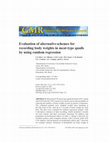
Genetics and molecular research: GMR
Data from 8759 meat-type quails from the UFV1 strain and 9128 from the UFV2 strain were used to a... more Data from 8759 meat-type quails from the UFV1 strain and 9128 from the UFV2 strain were used to assess the possibility of reducing the number of body weight records in genetic evaluations. The evaluated animals were weighed weekly since hatching to the 6th week of life, with up to 7 records of body weight for each bird. The data were evaluated by random regression models, with 9 alternative schemes of data recording, which included 4 records for each scheme and their covariance functions for additive and permanent environmental effects of order 3, fitting 4 intervals for residual variance, and a complete scheme, with 7 records, order of fit 6 for additive and permanent environmental effects and 7 intervals for residual variance. Estimates of heritability for body weight at the 6th week varied from 0.45 to 0.53 for the UFV1 strain and from 0.28 to 0.54 for UFV2 strain. The schemes that had more records in points at the final extreme of the age range showed better estimates, which was...
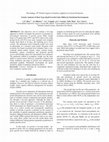
Abstract Text: Our objectives was to evaluate a two-step approach to further investigate the pres... more Abstract Text: Our objectives was to evaluate a two-step approach to further investigate the presence of genotype by environment interaction in growth curves. Body weight from 2,274 quails from UFV1 and UFV2 lines in ten crude protein levels (24-33%) were used. Animals were weighed weekly from hatch to 42 days old totalizing up to seven records. The parameters from Gompertz model were used as phenotypes in a reaction norm model. Reaction norm covariate was based on protein level estimates from a conventional animal model. Genetic values reaction norms, heritability, genetic correlations and projected growth curves and breeding values for each animal were estimated. The parameter related to asymptotic weight was the most stable in reaction norms. However, parameters related to the initial conditions and slope of growth were influenced by nutritional gradient. Nutritional environment for quails should be similar to minimize interaction effects. Keywords: Coturnix; Genotype by environm...

Ciência Rural, 2012
Estimação dos componentes de variância para as características de produção e de qualidade de ovos... more Estimação dos componentes de variância para as características de produção e de qualidade de ovos em matrizes de codorna de corte Estimative of the variances components for eggs production and quality characteristics in meat-type quail Recebido para publicação 29.01.11 Aprovado em 14.12.11 Devolvido pelo autor 05.03.12 CR-4699 RESUMO Dados de dois grupos genéticos UFV1 e UFV2 de matrizes de codorna de corte, com 629 animais no primeiro arquivo e 707 no segundo, foram avaliados pela técnica de componentes principais. Foram consideradas as seguintes características para análise: peso da ave (LOM4. As altas estimativas de herdabilidade encontradas indicam uma grande variabilidade para as características de qualidade dos ovos. As correlações genéticas mostram a possibilidade de ganhos correlacionados entre peso corporal e as características de qualidade dos ovos. Pequena resposta à seleção para produção de ovos pode ser esperada para estes grupos genéticos.
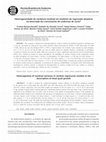
Revista Brasileira de Zootecnia, 2011
RESUMO -Para comparar a influência da heterogeneidade da variância residual nos parâmetros genéti... more RESUMO -Para comparar a influência da heterogeneidade da variância residual nos parâmetros genéticos estimados para a curva de crescimento de codornas de corte, foram utilizados dados provenientes de 26.835 e 27.447 observações, de 3.909 e 4.040 codornas de corte das linhagens UFV-1 e UFV-2, respectivamente. Foi avaliado o peso corporal nas duas linhagens, aos 1, 7, 14, 21, 28, 35 e 42 dias de idade, por meio de modelo animal em regressão aleatória, considerando na modelagem as variâncias residuais em classes de idades. Observou-se aumento no Log e L, significativo pelo teste da razão de verossimilhança (LRT), com o aumento do número de classes heterogêneas. Na modelagem da variância residual, foram consideradas classes de idade: homogênea: CL1 (uma classe): 1-42 dias; e as heterogêneas: CL2 (duas classes): 1 e 7-42 dias; CL3 (três classes): 1, 7 e 14-42 dias; CL4 (quatro classes): 1, 7, 14 e 21-42 dias; CL5 (cinco classes): 1, 7, 14 e 21 e 28-42 dias; CL6 (seis classes): 1, 7, 14, 21, 28 e 35-42 dias; CL7 (sete classes): 1, 7, 14, 21, 28, 35 e 42 dias de idade. O modelo que considerou homogeneidade de variância residual mostrou-se inadequado. As estimativas de variâncias, herdabilidades e correlações foram influenciadas pela modelagem da variância residual. A utilização de heterogeneidade de variância residual (CL7) para modelar as variâncias associadas à curva de crescimento das codornas de corte é necessária. Palavras-chave: Coturnix coturnix, curva de crescimento, herdabilidade, modelo animal, parâmetros genéticos Heterogeneity of residual variance in random regression models in the description of meat quail growth ABSTRACT -In order to compare the residual heterogeneity variance influence on the genetic parameters estimated for the growth curve of meat quail, data from 26835 and 27447 observations, from 3909 and 4040 meat quails of the UFV-1 and UFV-2 strains, respectively, were used. Body weight was evaluated, for the two strains, at 1, 7, 14, 21, 28, 35 and 42 days of age, through an animal model at random regression, considering residual variances in the age classes. Log e L showed increase, significant by the likelihood ratio test (LRT), with an increase in the number of heterogeneous classes. In the modeling, the following residual variances were considered in the age classes of: homogeneous: CL1 (one class): 1-42 days; and heterogeneous: CL2 (two classes): 1 and 7-42 days; CL3 (three classes): 1, 7 and 14-42 days; CL4 (four classes): 1, 7, 14 and 21-42 days; CL5 (five classes): 1, 7, 14, 21 and 28-42 days; CL6 (six classes): 1, 7, 14, 21, 28 and 35-42 days; CL7 (seven classes): 1, 7, 14, 21, 28, 35 and 42 days of age. The model that considered residual variance homogeneity showed unsuitable. Variance estimates, heritability and correlations were influenced by the modeling of the residual variance. The use of residual variance heterogeneity (CL7) to model the variances associated with the growth curve of meat quail is necessary.

Genetics and Molecular Research, 2013
The objective of this research was to study the factors that influence the test day milk yield (T... more The objective of this research was to study the factors that influence the test day milk yield (TDMY) and percentages of protein, fat, lactose, and total dry extract obtained on test day. We evaluated 110,732 weekly milk production records from 1496 goats and 19,271 monthly milk constituent records from 1245 Alpine and Saanen goats, which were collected from 1997 to 2010 in the goat sector at Universidade Federal de Viçosa. To ensure greater record reliability, only lactation data with kidding order between 1 to 6, type of kidding data including 0 to 3 kids, milk control years after 1997, and genetic groupings other than types 7 or 9 were considered, due to the relative lack of information recorded for some classes of these factors. Data in which the reported milk days were less than 7 or greater than 315 were also eliminated. Goats aged greater than 300 days at calving and those aged less than 6 years at control were considered in this study. Milk production was higher in the dry season in comparison to the rainy season. Genetic grouping did not influence all traits in both breedings. The TDMY tended to increase along with increasing age of the goats at kidding, while the opposite trend was observed relative to kidding order. Factors that significantly influenced all of the studied traits varied, and the factors that significantly influenced each trait were altered between the relationship of Alpine and Saanen breeds. Thus, the analysis of factors that influence traits to be evaluated in the herd under study is critical for defining the best evaluation model.











Uploads
Papers by Giovani Da Costa Caetano